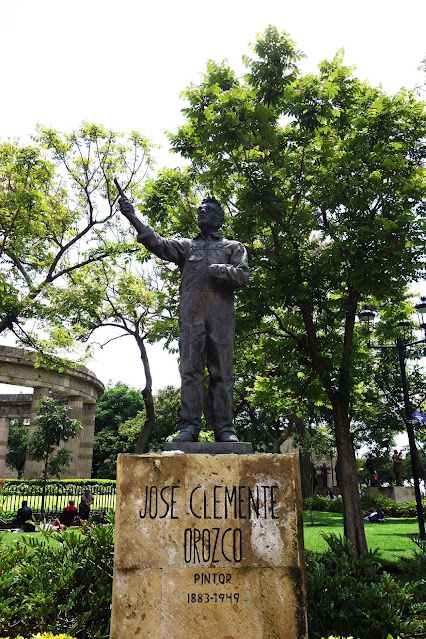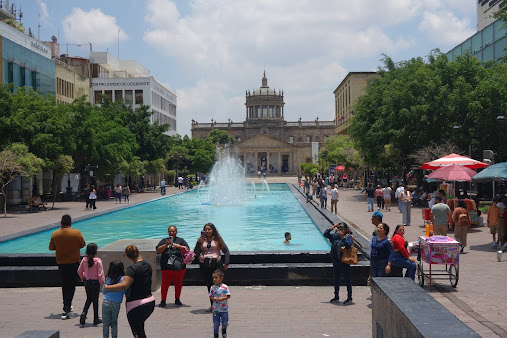Although the photos that I post here may look pretty, Guadalajara was a disappointment. It was close to forty years ago that I last was in Guadalajara, Mexico's second largest city and the capital of the state of Jalisco. At that time, I thought that the city center was very attractive. It had also been many years since Alejandro had been there, and he too thought that it was a very nice city. However, we both found the city to be a letdown.
On Sunday, we devoted the day to walking around the downtown area. Our hotel (which was also disappointing) was located on the Plaza de Armas, the city's main plaza. Directly opposite our balcony, on other side of the plaza is the Palace of Government of the State of Jalisco.
The interior of government building includes some important mural paintings, but since it is closed on Sundays, we could not go inside. The building was surrounded by barricades, perhaps to keep homeless people from spending the night sleeping in the doorways. On two sides of the plaza, including the side where our hotel was located there are porticos. At night, under the protection of the colonnades, dozens of indigent men stake out an area of the sidewalk to sleep. There were homeless people sleeping just a few feet away from the entrance to our hotel. During the day, they disappear, but each night they return.
To the side of the main plaza is the Cathedral of Guadalajara. The first cathedral, a primitive structure of adobe, was built in 1541, and was destroyed in a fire. A later church was destroyed in an earthquake, and the current building was completed in 1854.
A series of parks. plazas and pedestrian streets connect the city's two major monuments, the Cathedral and Hospicio Cabañas, a former orphanage which is now a museum.
On the other side of the Cathedral is a park which contains a circle of pillars called the Rotunda of the Famous. It honors famous people who were born in the state of Jalisco.
Around the perimeter of the park are bronze statues of famous people from Jalisco. This one is of José Clemente Orozco, one of the "Big Three" of Mexican mural painters.
Behind the Cathedral is another plaza, Plaza de la Liberación. It was here that Miguel Hidalgo, who began the struggle for independence from Spain, proclaimed the abolition of slavery.
The plaza also includes a recently added photo stop, the Guadalajara sign. Why is the name of the city repeated? The lyrics of one of the most famous mariachi songs begins "Guadalajara, Guadalajara!"
At the opposite end of the plaza is the Teatro Degollado. The theater, which was inaugurated in 1866, is the city's most important venue for concerts and cultural events. Late at night, its portico is also a refuge for homeless people.
Next to the theater is the Church of San Agustín. Its construction was completed in 1674.
Continuing down a pedestrian street is a statue of the coat of arms of Guadalajara, which was granted to the city in 1539 by Emperor Charles V. It consists of two lions standing to either side of an oak tree.
The pedestrian street widens into a broad esplanade called the Plaza Tapatía. ("Tapatío" is the nickname for anyone or anything from Guadalajara.) When I was here in the 1980s the plaza was brand new and very impressive. Now, nearly forty years later, the plaza and the buildings around it are showing their age, and it is lined with stalls selling tacky souvenirs.
The plaza ends at the Hospicio Cabañas, arguably the most important sight in the city, a building which has been designated a World Heritage Site by UNESCO.
The Hospicio Cabañas was founded in 1810, on the eve the Mexican War for Independence, by Bishop Juan Ruiz de Cabañas as an orphanage, hospital and almshouse. The building was designed by Manuel Tolsá, the famous Spanish-born architect and sculptor who introduced the neoclassical style to Mexico. The enormous building is a rectangle measuring 538 by 476 feet with 23 courtyards.
The building continued to serve as a hospital well into the 20th century. In 1935 the governor of the state of Jalisco invited José Clemente Orozco to paint a series of murals in the former chapel of the building. These paintings, which depict the Spanish conquest of Mexico, are regarded as one of Orozco's greatest achievements.
The mural in the cupula of the dome, over 100 feet above the floor, is called "Man on Fire", and is considered Orozco's masterpiece.
In front of the Hospicio, Alejandro poses with a fellow dressed as the mascot of Guadalajara's famous soccer team "Las Chivas".
From the Hospicio we walked a short distance to the Plaza de los Mariachis. Mariachi music originated in Guadalajara and is an iconic part of the city's heritage. This plaza is a traditional hangout for mariachi bands, but it was one of the biggest disappointments. In fact, given the fact that it is a tourist destination, it is a disgrace. On a Sunday afternoon there were only a couple of mariachi groups sitting around, and they were outnumbered by derelicts, probably drug addicts or drunks, sleeping on the sidewalks under the arches. Piles of trash were heaped in corners of the plaza.
We took a quick walk through the Libertad Market which is the largest covered marketplace in Latin America. The market building was quite innovative when it was constructed in the 1950s. Today it looks rather dingy, dirty and in need of renovation.
That was our day in Guadalajara, which sadly is not the city we remember from years ago.

























I only visited Guadalajara once, in 2011. Loved my visit there, with highlights being the Hospicio and a performance of the Ballet Folklorico at the Teatro Degollado (I think). LOVED Tlaquepaque.
ReplyDeleteAs for Plaza de los Mariachis, I found it underwhelming and seedy even then, and I remember my Lonely Planet guidebook cautioning me to exercise caution in the area. I enjoyed the nearby Mercado Libertad and had a really good breakfast there, although even then, many stalls were vacant.
All in all, I felt safe. Disappointed to hear about the rise in homelessness and dereliction in general, although that seems to be happening everywhere, including my Tennessee town of 30,000 people.
Great pictures, BTW.
-Scott
Both Alejandro and I liked the city very much on earlier visits, which made the current situation even sadder.
DeleteAs is so with any disappointing trip, you can tick it off as "been there, done that, and won't do it again." Was this trip in celebration of your August birthday?
ReplyDeleteNo, it was for the first communion of the daughters of one of Alejandro's cousins.
Delete